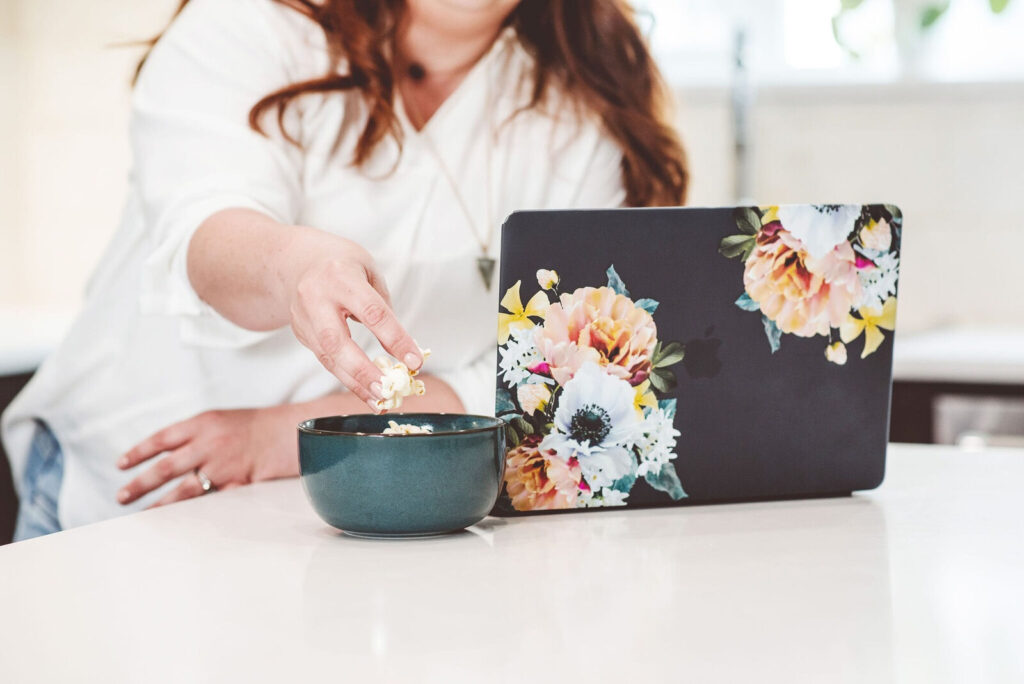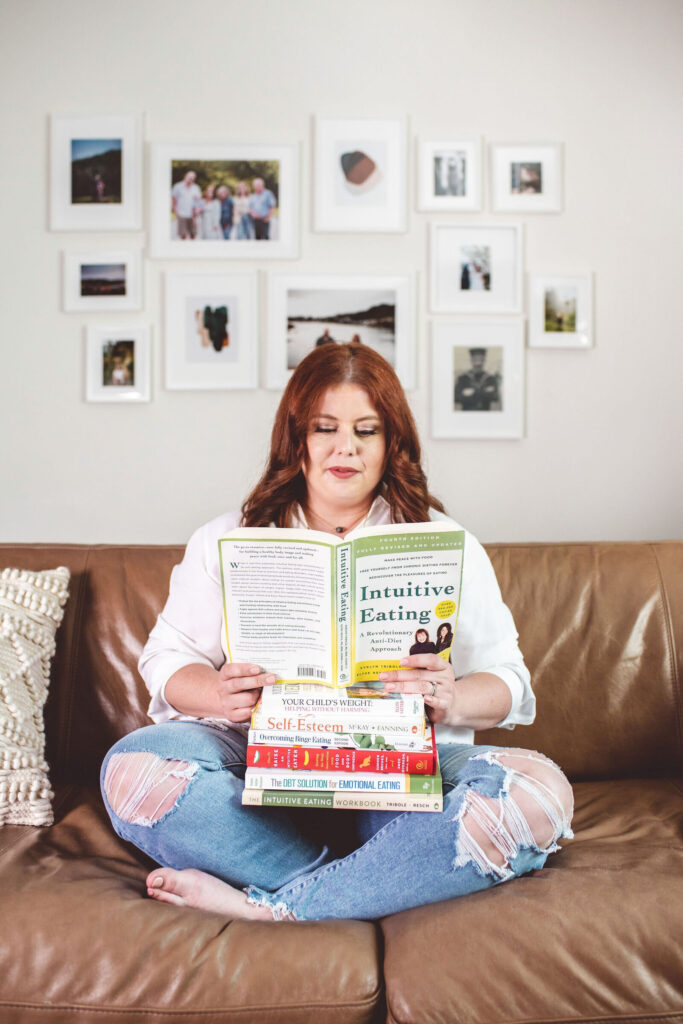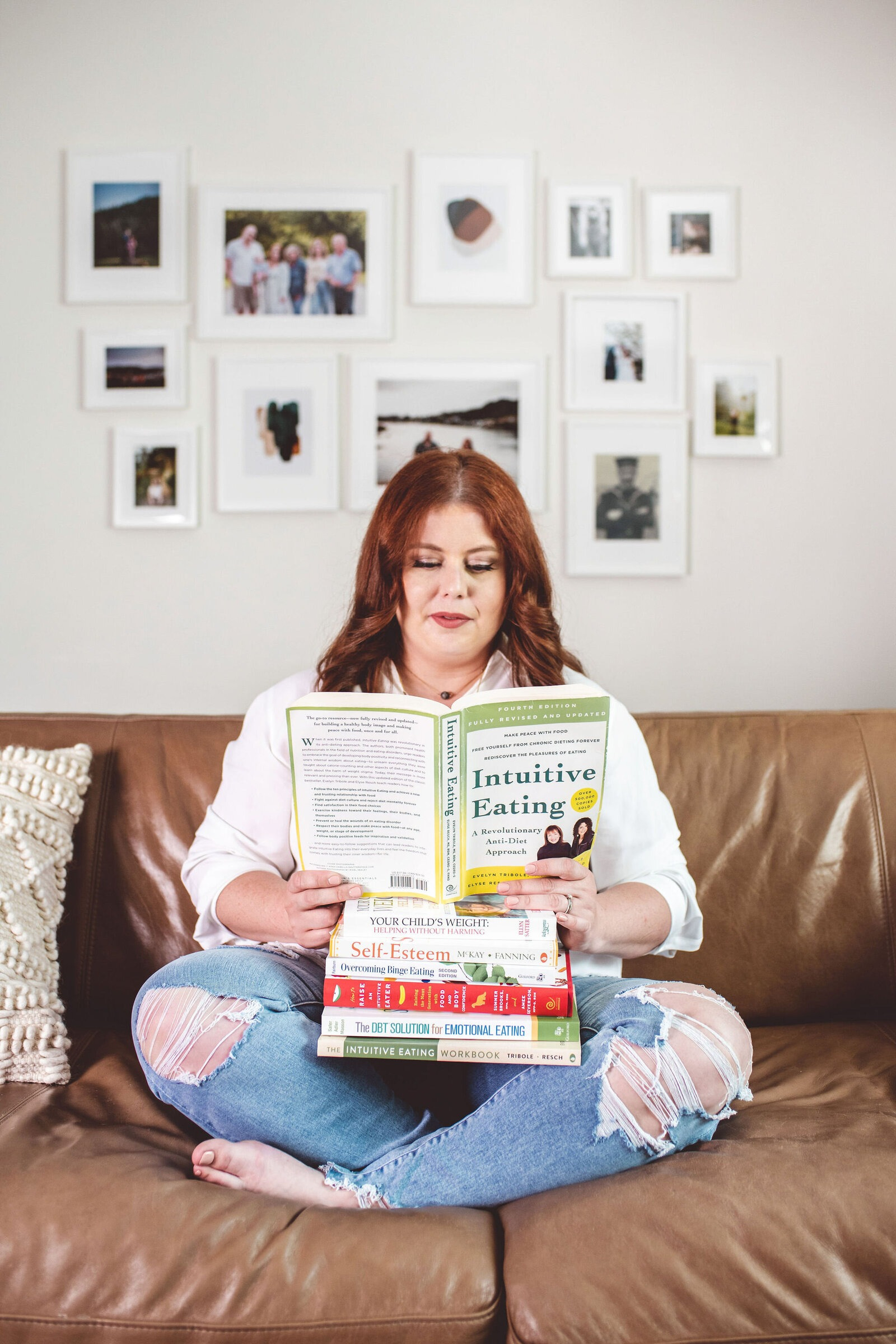Emotional eating is something many of us turn to when we feel overwhelmed, sad, lonely, or stressed. We eat not because we’re hungry, but because food helps us cope with those big feelings. But afterward, we often feel shame. That shame can lead to more emotional eating. It becomes a cycle: eat to feel better, feel ashamed, then eat again to escape the shame.
In this post, we’ll talk about how shame shows up after emotional eating and how you can start to break the cycle. Step by step, you’ll learn how to notice shame, interrupt it, and find new ways to care for yourself. You deserve peace with food. Let’s get started.
Hi, I’m Meredith MacKenzie, a binge eating therapist, intuitive eating coach, and creator of the One Body To Love program. If you’re stuck in the shame spiral after emotional eating, you’re not broken, and you’re definitely not alone. Emotional eating is a call for care, not judgment.
If you’re looking for support, there are a few ways we can work together. You might start with my self-paced course, Food Freedom in a Weekend or dive deeper with 1:1 mentorship. You can also explore all my favorite books and free resources right here. And for more support and real talk about food freedom and self-compassion, come join me on Instagram.

The Anatomy of the Shame Cycle
When shame shows up after emotional eating, it usually follows a pattern.
- Trigger event – Something hard happens. You feel stressed, lonely, or upset.
- Emotional eating – You eat to help yourself feel better or to escape the feeling.
- Short relief – For a little while, the food helps you feel comforted or distracted.
- Shame lands – Then guilt, regret, or self-blame shows up.
- Self-criticism – You might think things like “What’s wrong with me?” or “I have no willpower.”
- More eating – The shame is painful, so you eat again to try to numb it.
This cycle can feel like quicksand. Every step pulls you deeper. And once you’re in it, it’s hard to get out. But knowing how this cycle works is the first step toward change.
None of this means you’re broken. Emotional eating is one way your brain tries to keep you safe. And shame is a signal that something inside you needs care and attention. Let’s talk more about why emotional eating happens in the first place.
Struggling with the loss of comfort eating? You’re not alone. Read this blog for a gentle look at grief, food, and self-compassion: Grieving the Loss of Comfort Eating.
Why Emotional Eating Is a Survival Strategy
Emotional eating often gets labeled as a problem, but it’s actually your body’s way of trying to feel safe. When emotions like stress, sadness, or anger show up, your brain looks for relief. Food is a quick and familiar way to find comfort.
It can bring pleasure, distraction, or a sense of connection, especially if other soothing tools weren’t available growing up or life feels overwhelming now. So even if emotional eating feels frustrating, it comes from a place of survival, not weakness.
With time, though, it can leave you feeling stuck or ashamed. That’s when it helps to look beneath the behavior and begin to build new, more supportive ways to care for your emotions.
Next, let’s explore how self-criticism and perfectionism keep this cycle going.
Want to stop emotionally eating without shame or restriction? This blog offers simple, compassionate steps to help.
The Role of Self-Criticism and Perfectionism
After emotional eating, it’s common to turn frustration inward. You might think, “Why did I do that?” or “I have no self-control.” This kind of self-talk adds more pain and can push you deeper into the shame cycle.
Perfectionism makes it worse. If you expect yourself to eat “perfectly,” any slip feels like failure. And when you feel like you’ve failed, emotional eating can feel like the only way to cope.
But being hard on yourself doesn’t lead to change. It leads to more stress, and more eating to escape that stress. What helps instead is kindness, flexibility, and realistic expectations. You don’t need perfect eating. You need support and self-compassion.
Now let’s look at how you can start to interrupt the shame spiral when it begins.
How to Interrupt the Emotional Eating Shame Spiral
When you notice shame creeping in after emotional eating, it’s possible to slow things down and respond with care instead of criticism. Here are some steps you can try:
- Pause and notice what’s happening. Instead of reacting right away, take a moment. Say to yourself, “I’m feeling shame right now.” Naming it helps create space between you and the feeling.
- Take a few slow breaths. Ground yourself in the present moment. Breathing can calm your nervous system and give you a chance to think clearly.
- Remind yourself that you’re not broken. Emotional eating is a learned way of coping, not a personal flaw. You’re doing your best with what you know.
- Speak kindly to yourself. Imagine what you’d say to a friend. Try phrases like, “That was a hard moment,” or “I’m learning, and that’s okay.”
- Get curious, not judgmental. Ask gentle questions like: What was I feeling before I ate? What did I need in that moment? Curiosity helps you learn without shame.
- Reach for support. Sometimes talking to someone who gets it, a friend, therapist (hi!), or coach, can help you feel less alone and more grounded.
These steps take practice. You won’t do them perfectly, and that’s okay. Even one small pause is a powerful shift.
Feeling out of control with food? This video shares simple, supportive tips to help you move from overeating to more ease and freedom with food.
Building New Emotional Coping Tools
Next, let’s talk about building new tools for when emotions feel too big to handle on your own. As you interrupt the shame spiral, it’s helpful to explore other ways to care for yourself when emotions feel big. Emotional eating may still show up, and that’s okay. The goal isn’t to take food away, it’s to add more options.
Start by asking yourself what you were feeling before you ate. Were you stressed, lonely, or tired? Then try something small to support that feeling. Maybe it’s a short walk, a few deep breaths, a journal entry, or just placing a hand on your heart.
These tools don’t need to be perfect. They just need to help you pause and connect with what you truly need. Over time, you’ll build more trust in yourself, and emotional eating won’t feel like the only way to cope.
Looking for a gentle way to reconnect with your eating habits, without judgment? Download my free Mindful Eating Log to help you slow down, check in with your body, and better understand your emotional eating patterns.
The Long-Term Path to Peace with Food
Healing your relationship with emotional eating takes time, patience, and self-compassion. It’s not a straight line. Some days will feel easier. Others might bring setbacks. This doesn’t mean you’re failing, it means you’re human.
Peace with food isn’t about never eating emotionally again. It’s about building a life where food is just food. It’s about learning to feel your feelings, trust your body, and respond with care instead of shame.
Over time, emotional eating becomes less urgent. Shame softens. And you begin to feel more in control, not because you’re forcing yourself, but because you’re listening to yourself.
You don’t need to do this perfectly. You just need to stay curious and kind. Each step you take matters. You are worthy of that gentleness and peace.

Finding Freedom from Emotional Eating
Emotional eating doesn’t mean you’re weak. It means you’ve been doing your best to survive in a world that hasn’t always supported your needs. By understanding the shame cycle, getting curious about your feelings, and building new ways to care for yourself, you can begin to change your relationship with food. This work takes time, but it’s worth it.
Feeling at home in your body and at peace with how you eat is possible, you truly deserve that. And navigating emotional eating or the shame that follows it doesn’t have to be something you do alone.
My group coaching program, One Body To Love, offers a supportive, judgment-free space to help you step out of survival mode, release self-blame, and reconnect with your body in a way that feels safe and sustainable.
If you’re looking for more personalized support, 1:1 coaching offers a deeper space to explore the emotional roots of your eating patterns with compassion and curiosity. Not sure what kind of support is right for you? I’d love to chat, book a free discovery call today.
Want to start with free resources? Check out my YouTube channel and podcast, One Body To Love, for honest conversations, real-life tools, and guidance to help you feel less alone on this journey.
